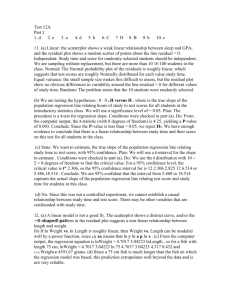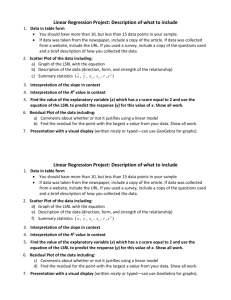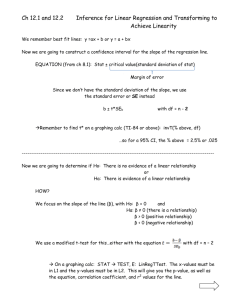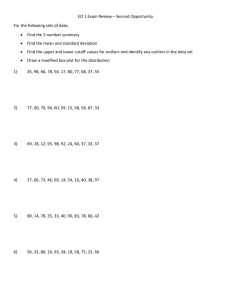AP Statistics
advertisement
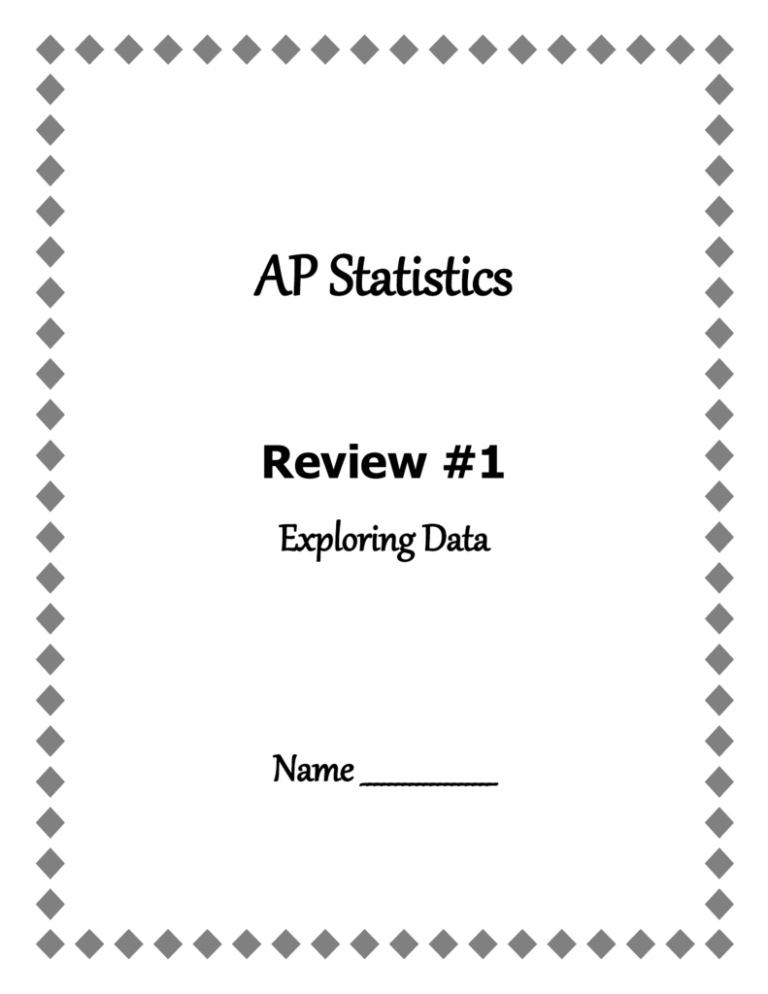
AP Statistics Review #1 Exploring Data Name ___________________ AP Statistics Exploring Data Review I. Exploring Data: Describing patterns and departures from patterns (20%-30%) Exploratory analysis of data makes use of graphical and numerical techniques to study patterns and departures from patterns. Emphasis should be placed on interpreting information from graphical and numerical displays and summaries. A. Constructing and interpreting graphical displays of distributions of univariate data (dotplot, stemplot, histogram, cumulative frequency plot) 1. Center and spread 2. Clusters and gaps 3. Outliers and other unusual features 4. Shape B. Summarizing distributions of univariate data 1. Measuring center: median, mean 2. Measuring spread: range, interquartile range, standard deviation 3. Measuring position: quartiles, percentiles, standardized scores (z-scores) 4. Using boxplots 5. The effect of changing units on summary measures C. Comparing distributions of univariate data (dotplots, back-to-back stemplots, parallel boxplots) 1. Comparing center and spread: within group, between group variation 2. Comparing clusters and gaps 3. Comparing outliers and other unusual features 4. Comparing shapes D. Exploring bivariate data 1. Analyzing patterns in scatterplots 2. Correlation and linearity 3. Least-squares regression line 4. Residual plots, outliers, and influential points 5. Transformations to achieve linearity: logarithmic and power transformations E. Exploring categorical data 1. Frequency tables and bar charts 2. Marginal and joint frequencies for two-way tables 3. Conditional relative frequencies and association 4. Comparing distributions using bar charts Tips and Hints: When you analyze one-variable data, always discuss shape, center, and spread. Remember your SOCS! (And don’t forget the context!!) Look for patterns in the data first, and then look for deviations from those patterns. When commenting on shape: * Symmetric is not the same as "equally" or "uniformly" distributed. * Do not say that a distribution "is normal" just because it looks symmetric and unimodal. Treat the word "normal" as a "four-letter word." You should only use it if you are really sure that it's appropriate in the given situation. Don't confuse median and mean. They are both measures of center, but for a given data set, they may differ by a considerable amount. * If distribution is skewed right, then mean is greater than median, however, Mean > median is not sufficient to show that a distribution is skewed right. * If distribution is skewed left, then mean is less than median, however, Mean < median is not sufficient to show that a distribution is skewed left. Don't confuse standard deviation and variance. Remember that standard deviation units are the same as the data units, while variance is measured in square units. Remember that the variance is the standard deviation squared When s=0, all of the data points are the same value. Know how transformations of a data set affect summary statistics. (a) Adding (or subtracting) the same positive number k, to (from) each element in a data set increases (decreases) the mean and median by k. The standard deviation and IQR do not change. (b) Multiplying all numbers in a data set by a constant k multiplies the mean, median, IQR, and standard deviation by k. For instance, if you multiply all members of a data set by four, then the new set has a standard deviation that is four times larger than that of the original data set, but a variance that is 16 times the original variance. Be able to create a histogram, boxplot, scatterplot, etc by hand, as well as by the TI. When testing for outliers, remember that typically the rule we use is that outliers are values that are beyond the “fences” of 1.5(IQR) beyond the box on either side. When comparing graphs, make sure you use comparative language such as higher, lower, more, less, etc. Listing the attributes of center, spread, etc will give you a partial at best!! When describing a scatterplot: * Comment on strength, outliers, form, and association of the relationship. (SOFA) * Look for patterns in the data, and then for deviations from those patterns. A correlation coefficient near 0 doesn't necessarily mean there are no meaningful relationships between the two variables – just not a linear relationship! Don't confuse correlation coefficient and slope of least-squares regression line. * A slope close to 1 or -1 doesn't mean strong correlation. * An r value close to 1 or -1 doesn't mean the slope of the linear regression line is close to 1 or -1. * The relationship between b (slope of regression line) and r (coefficient of correlation) is b= r(Sy/Sx)…. This is on the formula sheet provided with the exam. * Remember that r2 > 0 doesn't mean r > 0. For instance, if r2 = 0.81, then r = 0.9 or r = -0.9. Know where to find the slope and y-intercept formulas on the formula sheet!!! You should know difference between a scatter plot and a residual plot. For a residual plot, be sure to comment on: * Whether the residuals appear to be randomly distributed * A good residual plot has NO pattern!! * A curved pattern indicates a non-linear relationship Given a least squares regression line, you should be able to correctly interpret the slope and y-intercept in the context of the problem. * Slope = change in the predicted y-variable as x-variable increases by APPROXIMATELY 1 unit * Y-intercept = predicted value of the y-variable when x=0 (Not always valid!) Remember properties of the least-squares regression line: * Contains the point (x-bar, y-bar), where x-bar is the mean of the x-values and ybar is the mean of the y-values. * Minimizes the sum of the squared residuals (vertical deviations from the LSRL) If working with bivariate data, make sure to turn DiagnositicOn in the 2nd: Catalog menu so that your r and r2 will show up! (You should only have to do this once) Residual = (actual y-value of data point) - (predicted y-value for that point from the LSRL) A residual plot can give you a feel for if the line is a good fit. By plotting the xvariable against the residuals, you can determine if the linear regression is appropriate. Anytime you do a LinReg, a residual list is automatically created and stored in the RESID list found under 2nd:Stat. You can create a residual plot by going to StatPlot and choosing a scatterplot with your x-list and the RESID list as the y-list. Zoom-9 to see the graph. If the line is not a good fit, you have to transform the data and try again. By performing various mathematical operations on your list and running your LinReg on the transformed data and looking at the residual plots, you can find a better fit. The typical transformations we do are: * Logging the x-variable only -> logarithmic regression * Logging the y-variable only -> exponential regression * Logging both the x and y variables -> power regression Remember that z-scores are the number of standard deviations a value is from the mean. A z-score can always be found, but can only be converted to percentiles if we know the distribution is a Normal model. Be able to use your Normal tables to find probabilities. Be able to read an ogive (a cumulative frequency graph) to find percentiles. Some values are more resistant to the effects of outliers than others. When dealing with outliers, be careful of using values like the mean, standard deviation, and correlation, as they are all influenced by outliers. The properties of r: always a number between -1 and +1; the sign tells the direction; r is not affected by which variable is x or y or by changing units (like cm to inches); r only applies to linear relationships!!! Squaring the correlation can give you a better feel for the relationship. R2 tells the percent of the variation in the y-variable that can be explained by the regression between x and y. Be able to calculate the LSRL using summary statistics (the slope: b=r(Sy/Sx) and the y-intercept: a=y-bx) AND how to find the LSRL using LinReg (Stat:Calc) From POWs – Cereal comparison problem, Dad vs Daughter problem, Ogive problem, Urban vs Rural problem 2011B #1 2009B #1 2001 #1 2005B #5 2006 #1 2004B #5





